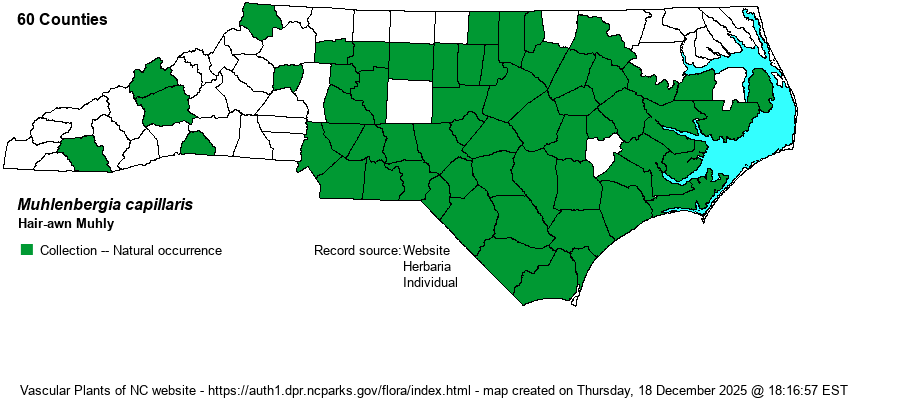| Author | (L.) Trinius | |
| Distribution | Piedmont, Sandhills, and Coastal Plain; scattered in the Mountains.
MA to southern OH and KS, south to FL and TX. | |
| Abundance | Frequent to common in the Coastal Plain, Sandhills, and eastern two-thirds of the Piedmont; scarce in the Mountains and western Piedmont. Seemingly not numerous in the northern NC counties. For some reason, the NCNHP has its State Rank as S3, but it is clearly an S5 species in NC. | |
| Habitat | Mesic to dry hardwoods and pine-hardwood woodlands, openings in these habitats; loamy sands of Longleaf Pine savannas, loamy pea swales in the Sandhills; mafic glades, rock outcrops, oak-hickory-Red Cedar woodlands. This grass responds well to recurring fire. | |
| Phenology | Flowering and fruiting August-October. | |
| Identification | This is a very distinctive and beautiful grass -- large populations look like a pink-purple mist. It likely can be confused only with Eragrostis spectabilis and Digitaria cognata, which see. The inflorescence occupies half the plant's height. Its close relative M. sericea occurs in maritime soils and has much longer awns on the glumes (2-25 mm long vs. 1-5 mm long). | |
| Taxonomic Comments | Some authors lump it with M. sericea and M. expansa, but those are clearly distinct species; see the discussion by Weakley (2018).
In NC the genus Muhlenbergia assumes 2 very different forms of inflorescences: very open and airy or narrow and elongate, with short branches. In both cases, attention to details of the key is important, along with a dissecting scope. Once learned, however, most muhlys can be identified on sight in the field. Spikelets contain a single floret (rarely 2-3). | |
| Other Common Name(s) | Hairgrass, Gulf Muhly, Pink Hairgrass | |
| State Rank | S3 [S4] | |
| Global Rank | G5 | |
| State Status | | |
| US Status | | |
| USACE-agcp | FAC link |
| USACE-emp | FACU link |

